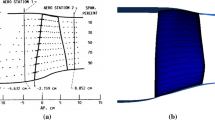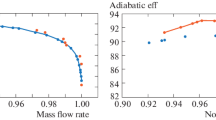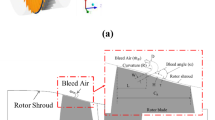Abstract—
The performance and stability of a low-bypass turbofan transonic axial compressor with a nonuniform inlet flow is a significant concern in recent times. In both military and commercial aircraft, serpentine ducts produce significant inlet swirl distortion. Moreover, the nonuniform inlet flow frequently acts upon aircraft gas-turbine engines causing deteriorating effects on the aircraft engine. High circumferential swirl flows and inlet flow angularity decrease the aerodynamic performance and the stall margin and increase the rotor blade loading. The current paper is aimed at the investigation of the flow field in the tip clearance region of low-bypass turbofan transonic compressor rotor under nonuniform circumferential flow conditions through numerical simulation using Ansys CFX. The mathematical models based on 1D Mean Line Code and Dynamic Turbine Engine Compressor Code (DYNTECC) are used to analyze the nonuniform inlet swirl flow of the compressor rotor. The mathematical model is limited to compute the multistage compressor characteristics for the compression system and the combustor of a turbine engine. For the single-stage swirl flow analysis current paper focuses on the CFD based results. The results based on CFD show that co-swirl patterns slightly improve the stability range of the compressor; counter-swirl flows diminish it.









Similar content being viewed by others
REFERENCES
A. Mehdi, Effect of Swirl Distortion on Gas Turbine Operability, School of Engineering Power and Propulsion Department, Cranfield University, May 2014.
Y. Sheoran and B. Bouldin, “Inlet flow angularity descriptors proposed for use with gas turbine engine,” in: Proceedings of Society of Automotive Engineer (SAE) Technical Conference, India, 2002.
W. Pazur and L. Fottner, “The influence of inlet swirl distortions on the performance of a jet propulsion two-stage axial compressor,” J. Turbomachinery 113, 233–240 (1991).
K. M. Loeper and P. I. King, “Numerical investigation of geometric effects on performance of S-ducts,” in: IAA 2009-713, 47th AIAA Aerospace Sciences Meeting Including the New Horizons Forum and Aerospace Exposition, Orlando, Florida, January 2009.
M. Davis and A. Hale, “A parametric study on the effects of inlet swirl on compression system performance and operability using numerical simulations,” in: GT2007-27033, ASME Turbo Expo 2007: Power for Land, Sea, and Air, Montreal, Canada, May 2007.
A. Hale and W. O’Brien, “A three-dimensional turbine engine analysis compressor code (TEACC) for steady-state inlet distortion,” ASME J. Turbomachinery 4, 422–430 (1999).
R. V. Chima, “A three-dimensional unsteady CFD mode of compressor stability,” ASME Journal of Turbomachinery, 1157–1168 (2008).
J. Guo and J. Hu, “A three-dimensional computational model for inlet distortion in fan and compressor,” J. Power Energy 232, 1–13 (2018).
A. J. Strazisar, J. R. Wood, M. D. Hathaway, and K. L. Suder, “Laser anemometer measurements in a transonic axial-flow fan rotor,” NASA Scientific and Technical Division, Lewis Research Center, Cleveland, Ohio, 1989.
S. L. Smith, “One-dimensional mean line code technique to calculate stage-by-stage compressor characteristics,” University of Tennessee, Knoxville, 1999.
R. N. Pinto, R. Nivea, A. Afzal, L. Vinson, D’Souza, and Z. Ansari, “A review of state of the art archives of computational methods in engineering,” in: Archives of Computational Methods in Engineering, Barcelona, Spain, 2016.
J. F. Hu, X. Ch. Zhu, H. OuYang, X. Q. Qiang, and Zh. H. Du, “Performance prediction of the transonic axial compressor based on the streamline curvature method,” J. Mechanical Science and Technology 12, 3037–3045 (2011).
I. Templalexis, P. Pilidis, V. Pachidis, and P. Kotsiopoulos, “Development of a 2D compressor streamline curvature code,” in: SME Turbo Expo, Power for Land, Sea, and Air, Barcelona, Spain, 2006.
C. Schwenk, G. W. Lewis, and M. J. Hartman, “A preliminary analysis of the magnitude of shock losses in transonic compressors,” NASA Paper, 1957.
W. C. Swan, “A practical method of predicting transonic compressor performance,” J. Eng. Power, 322–330 (1961).
N. J. Fredrick, “Investigation of the effects of inlet swirl on compressor performance and operability using a modified parallel compressor model,” University of Tennessee, Knoxville, 2010.
R. H. Aungier, “Axial-flow compressor: A strategy for aerodynamic design and analysis,” in: ASME, New York, 2003.
M. U. Sohail, H. R. Hamdani, and K. Parvez, “CFD analysis of tip clearance effects on the performance of transonic axial compressor,” Fluid Dynamics 55(1), 133–144 (2020).
M. U. Sohail, M. Hassan, H. R. Hamdani, and K. Parvez, “Effects of ambient temperature on the performance of turbofan transonic compressor by CFD analysis and artificial neural networks”, Engineering, Technology & Applied Science Research 9(5), 4640–4648 (2019).
B. Bouldin and Y. Sheoran, “Impact of complex swirl patterns on compressor performance and operability using parallel compressor analysis ISABE2007-1140,” in: 18th International Symposium on Air Breathing Engines, Beijing, China, September 2007.
M. Davis, D. Beale, and Y. Sheoran, “Integrated test and evaluation techniques as applied to an inlet swirl investigation using the F109 gas turbine engine,” in: GT2008-50074, ASME Turbo Expo 2008: Power for Land, Sea, and Air, Berlin, Germany, June 2008.
G. R. Miller, G. W. Lewis, and M. J. Hartmann, “Shock losses in transonic rotor rows,” J. Eng. Power, 235–242 (1961).
Y. S. B. Bouldin, “Impact of complex swirl patterns on compressor performance and operability using parallel compressor analysis,” in: ISABE2007-1140, 18th International Symposium on Air Breathing Engines, Beijing, China, 2007.
Author information
Authors and Affiliations
Corresponding authors
Rights and permissions
About this article
Cite this article
Sohail, M.U., Hamdani, H.R. & Parvez, K. Flow Angularity and Swirl Flow Analysis on Transonic Compressor Rotor by 1-Dimensional Dynamic Turbine Engine Compressor Code and CFD Analysis. Fluid Dyn 56, 278–290 (2021). https://doi.org/10.1134/S0015462821010134
Received:
Revised:
Accepted:
Published:
Issue Date:
DOI: https://doi.org/10.1134/S0015462821010134




